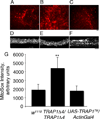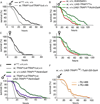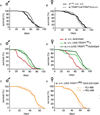Mitochondrial chaperone TRAP1 activates the mitochondrial UPR and extends healthspan in Drosophila
- PMID: 25265088
- PMCID: PMC4310785
- DOI: 10.1016/j.mad.2014.09.002
Mitochondrial chaperone TRAP1 activates the mitochondrial UPR and extends healthspan in Drosophila
Abstract
The molecular mechanisms influencing healthspan are unclear but mitochondrial function, resistance to oxidative stress and proteostasis are recurring themes. Tumor necrosis factor Receptor Associated Protein 1 (TRAP1), the mitochondrial analog of Hsp75, regulates levels of reactive oxygen species in vitro and is found expressed at higher levels in tumor cells where it is thought to play a pro-survival role. While TRAP1-directed compartmentalized protein folding is a promising target for cancer therapy, its role at the organismal level is unclear. Here we report that overexpression of TRAP1 in Drosophila extends healthspan by enhancing stress resistance, locomotor activity and fertility while depletion of TRAP1 has the opposite effect, with little effect on lifespan under both conditions. In addition, modulating TRAP1 expression promotes the nuclear translocation of homeobox protein Dve and increases expression of genes associated with the mitochondrial unfolded protein response (UPR(mt)), indicating an activation of this proteostasis pathway. Notably, independent genetic knockdown of components of the UPR(mt) pathway dampen the enhanced stress resistance observed in TRAP1 overexpression flies. Together these studies suggest that TRAP1 regulates healthspan, potentially through activation of the UPR(mt).
Keywords: Ageing; Drosophila; Healthspan; Mitochondria; TRAP1; UPR.
Copyright © 2014 Elsevier Ireland Ltd. All rights reserved.
Conflict of interest statement
The authors declare no conflicts of interest.
Figures







References
Publication types
MeSH terms
Substances
Grants and funding
LinkOut - more resources
Full Text Sources
Other Literature Sources
Molecular Biology Databases
Research Materials
Miscellaneous

